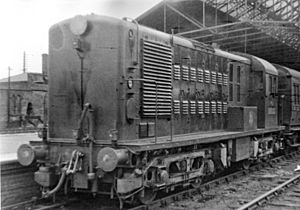British Rail 10800 facts for kids
Quick facts for kids British Railways 10800 |
|
 |
|
| 10800 on the down main platform at Rugby | |
| Power type | Diesel-electric |
|---|---|
| Builder | North British Locomotive Company |
| Serial number | 26413 |
| Build date | 1 July 1950 |
| Configuration | Bo-Bo |
| AAR wheel arr. | B-B |
| UIC classification | Bo′Bo′ |
| Gauge | 4 ft 8 1⁄2 in (1,435 mm) standard gauge |
| Wheel diameter | 3 ft 6 in (1.067 m) |
| Minimum curve | 3.75 chains (247.50 ft; 75.44 m) |
| Wheelbase | 31 ft 0 in (9.45 m) |
| Length | 41 ft 10+1⁄2 in (12.76 m) |
| Width | 9 ft 2 in (2.79 m) |
| Height | 12 ft 9+1⁄2 in (3.90 m) |
| Locomotive weight | 69.80 long tons (70.92 t; 78.18 short tons) |
| Fuel capacity | 300 imp gal (1,400 L; 360 US gal) |
| Coolant capacity | 85 imp gal (390 L; 102 US gal) |
| Water capacity | 90 imp gal (410 L; 110 US gal) |
| Prime mover | Paxman 16RPHXL Series 2 rebuilt: Maybach MD655 |
| Generator | DC |
| Traction motors | BTH 159, DC, four (4) off |
| Cylinder size | 7 in × 7+3⁄4 in (177.80 mm × 196.85 mm) rebuilt: 7+1⁄4 in × 8+3⁄4 in (184.15 mm × 222.25 mm) |
| Transmission | Diesel electric |
| Multiple working | Not fitted |
| Power output | 827 hp (617 kW) rebuilt: 1,400 hp (1,000 kW) |
| Tractive effort | 34,500 lbf (153.5 kN) |
| Train heating | Clarkson steam generator |
| Locomotive brakes | Brakeforce: 45 long tons-force (450 kN) |
| Train brakes | Vacuum |
| Power class | 3MT; later: Type 1 |
| Axle load class | Route availability: 4 |
| Retired | 8 August 1959 |
| Disposition | Sold Brush Traction, rebuilt into research locomotive Hawk, retired 1968, cannibalised 1972–1976, scrapped 1976. |
British Railways 10800 was a special diesel locomotive built in 1950. It was made for British Railways by the North British Locomotive Company. Even though it was ordered in 1946 by the London, Midland and Scottish Railway, it only appeared after the railways became national (owned by the government) in 1948. This train was one of the first diesel locomotives used by British Railways.
Contents
What Made It Special?
British Railways 10800 was a "prototype" locomotive. This means it was built as a test model. Engineers wanted to try out new ideas for diesel engines. It helped them learn how to build better diesel trains in the future.
Its Engine and Power
The locomotive first used a Paxman engine. This engine gave it about 827 horsepower. Later, it was rebuilt with a different engine, a Maybach MD655. This new engine was much more powerful, giving the train about 1400 horsepower! This change helped engineers compare different engine types.
How It Moved
Like many diesel trains, 10800 was a diesel-electric locomotive. This means its diesel engine powered a generator. The generator then made electricity. This electricity powered motors that turned the wheels. It could reach a top speed of 70 miles per hour.
Its Life and Retirement
Locomotive 10800 was used by British Railways for a few years. It helped them understand how diesel trains worked on their lines.
Becoming the 'Hawk'
In 1959, British Railways decided to retire 10800. It was then sold to a company called Brush Traction. They rebuilt the locomotive and renamed it Hawk. It was used as a special research train. This means it helped test new railway technologies.
Its Final Days
The Hawk was retired in 1968. Parts of it were used for other projects between 1972 and 1976. Finally, the rest of the locomotive was scrapped in 1976. Even though it's gone, 10800 played an important role in the history of British railways. It helped pave the way for modern diesel trains.

